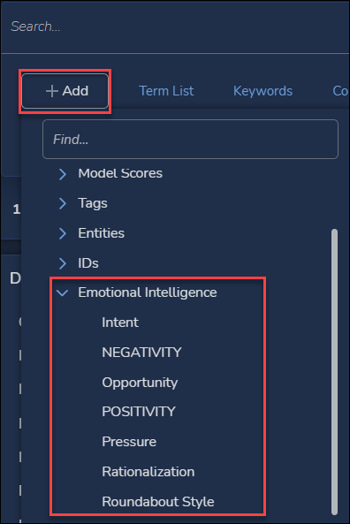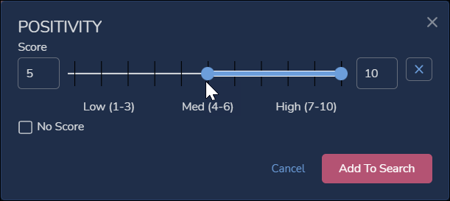Applying AI analysis of positive and negative sentiment in text to search and review.
Non-Audio Video Tutorial
Emotional Intelligence uses natural language processing tools to assess the emotional content of document text and scores it automatically. The assessments currently cover:
- Intent
- Negativity
- Opportunity
- Positivity
- Pressure
- Rationalization
- Roundabout Style
These scores are presented in an interactive graphic at the bottom of the Dashboard display and in a settable search condition.
Emotional Intelligence (also known as "Sentiment") uses natural language processing enhanced with Reveal analytics to assess and score the content of a message. Documents are scored on a scale of 0-10 (0 = neutral, 1 = lowest, 10 = highest) for Negativity or Positivity. To illustrate, here are a few examples (estimates, for illustration only) excerpted from Mark Twain's "The Celebrated Jumping Frog of Calaveras County":
In compliance with the request of a friend of mine, who wrote me from the East, I called on good-natured, garrulous old Simon Wheeler, and inquired after my friend's friend, Leonidas W. Smiley, as requested to do, and I hereunto append the result. [Medium-to-High Positive, it would likely be scored 6 or 7.]
"What might it be that you've got in the box?" [This question is neither positive nor negative, offering an example of a neutral 0 score.]
And then he see how it was, and he was the maddest man he set the frog down and took out after that feller, but he never ketchd him. [Highly Negative, a probable 9 or 10. Jim Smiley was extremely peeved.]
Reveal uses Emotional Intelligence to help reviewers drill down past keywords, phrases, places and events to weigh what those involved expressed in their own words and retrieve relevant material with an initial assessment of their sentiments. There are two main methods in the Dashboard to add Emotional Intelligence as a filter or search element.
Emotional Intelligence Dashboard Graphic

Found at the bottom of the Dashboard screen, this graph sets out shaded bars of NEGATIVITY and POSITIVITY and the other emotional intelligence criteria for the currently retrieved document set. The shadings, which may be selected with a click to serve as a filter, represent for each item’s scoring:
- Unscored (palest) - documents such as images which offer no text for analysis and scoring.
- Neutral (0) - documents which are neither positive nor negative, such as numerical spreadsheets or programming code or bland correspondence.
- Low (1 - 3) - documents scored for mild negativity or positivity.
- Medium (4 - 6) - documents scored for moderate negativity or positivity.
- High (7 - 10) - documents scored for high negativity or positivity.
Clicking on any section will add a pill to the search box to serve as a filter, retrieving only documents in the current set scored within the selected range.
How to Search on Emotional Intelligence
Emotional Intelligence may also be added as a condition under Advanced Search.
- With or without a search term active, open Advanced Search using the button to the right of the Search Bar.
- Open Add to Emotional Intelligence, expand and select POSITIVITY for this example.

- POSITIVITY selection opens a window to set the score range sought using the slider or entering a bottom and top range value in the Score boxes at either end. You may also select Neutral documents by setting both values or the slider to 0.

-
The No Score checkbox is for Unscored documents, which are documents that owing to format or lack of textual information have not been analyzed for scoring.
- Click Add To Search to add this condition to the search.

- Click Search to apply and add further conditions.
Emotional Intelligence Language Support
Reveal Emotional Intelligence supports positive/negative sentiment analysis in the following languages:
|
Arabic |
|
English |
|
French |
|
Japanese |
|
Persian |
|
Spanish |
For Intent, Opportunity, Pressure, Rationalization and Roundabout Style, we support the following languages: Chinese, English, German, Japanese, Korean, Portuguese, Spanish.
|
Chinese |
|
English |
|
German |
|
Japanese |
|
Korean |
|
Portuguese |
|
Spanish |
Last Updated 2/01/2024
